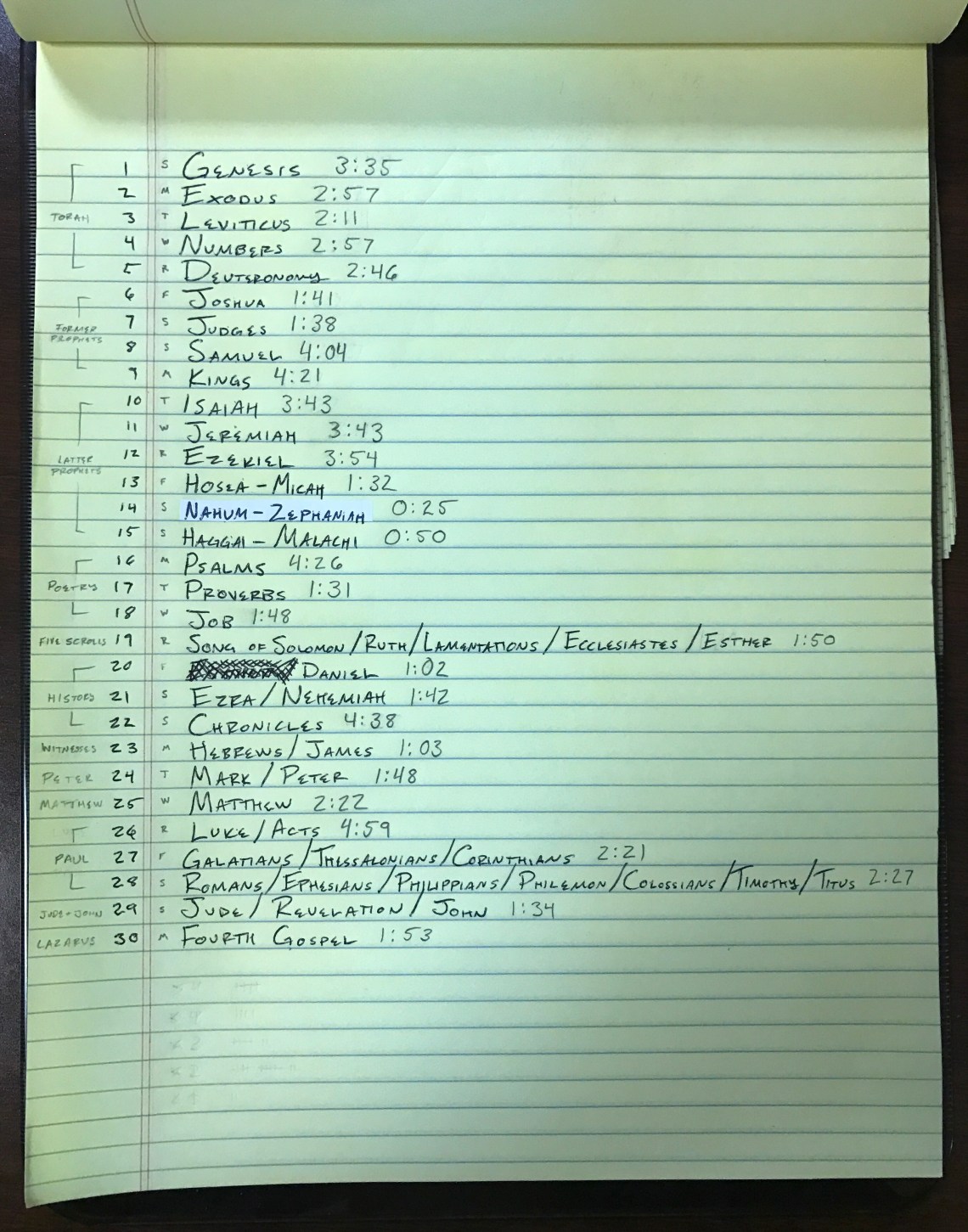Here’s a picture of my Bible reading plan for 2017 with an estimated reading time required per day. This will be the second time I’ve read through the Bible in a month, and I’ve renewed my approach a little.

Each line represents a day of the month. There are 30 total planned reading days. That gives me a one day buffer if I miss or fail to complete a reading, though I don’t intend to use it.
–
Earlier this year when I read through the Bible in January, I simply used the modern typical ordering of the books. In 2017 I plan to use the ordering of the Tanakh for the pre-Christ Hebrew portion. I am mainly doing this because it’s the way that the creator of Bibliotheca has chosen, and that’s what I’ll be reading from assuming it arrives in time. I am looking forward to experiencing the text in the order it would have been known to the Jews.
–
There were 24 “books” in the Tanakh, and I am coming pretty close to reading one per day. I’ve made two exceptions to this. (1) I’ve grouped together “The Five Scrolls” in one day since they are all relatively short and successive in the middle of the “Writings” (2) I’ve split “The Twelve” minor prophets between three days. The first day I will read the prophets from before the Assyrian captivity, next come the prophets that are both post-Assyrian and pre-Babylonian captivity, then finally on the third day I’ll read the prophets from after their release from Babylon’s oppression by Cyrus of Persia. There is still a chance that I’ll read all twelve of these in one day, since doing so would take less than three hours. That would either get me done early or give me additional buffer days.
–
After figuring out how to plan my Old Testament reading days, I felt it would be too boring just to read through the New Testament in the familiar order.
–
I will start with Hebrews and James. Hebrews was chosen here mainly because it does a lot of teaching on how to understand and apply the old scriptures to Christ, and because if it’s references to the cloud of witnesses inspiring faith in Christ. James also makes some similar references and a lot of behavioral applications of the gospel. Really he is mainly there because he needed a place to be and didn’t fit well into any other grouping. I read a few sources that suspected James might have been the earliest writing in the New Testament.
–
Next comes Mark, which many believe to be the first written gospel. Early extra-biblical sources associate Mark’s gospel with Peter’s teachings, as if Mark wrote down the things that Peter taught about Christ. I’ve grouped Peter’s epistles to be read alongside Mark for this reason.
–
The other two synoptic gospels seem borrow heavily from Mark, which would make sense in this context considering Peter’s renown as far as how featured he is as an early church leader compared with the other apostles. Matthew is a less prominent apostle in scripture, so perhaps it makes sense that he would use a work closely associated with Peter as a sort of starting point for his own eyewitness account.
–
Luke was not necessarily an eyewitness of Jesus at all, and admits from the outset that his work is one compiled from the testimonies of others concerning Jesus. That would explain much of what he seems to have borrowed from Mark and Matthew. Additionally Luke was a close companion of Paul, and certainly heard Paul preach the gospel on many occasions, which probably influenced his own gospel-sharing style. I think there is a good case to be made for Luke’s whole purpose for writing being to explain Paul’s circumstances as a prisoner to some Roman official. His account ends with Paul waiting in prison in Rome. I plan to read Luke and Acts back to back in one huge day of reading spans over a quarter of the New Teatament, at least by word count. The following two days I will read through Paul’s epistles in a roughly chronological order.
–
I plan to read John’s writings alongside Jude. I read somewhere that Revelation was probably written before John’s epistles, so I’ll read it before them.
–
The last day I’ll read one of my favorite things to read in the Bible, the fourth gospel. I don’t actually think it was written by the apostle John (a blog post for another day perhaps), so it’s position has little to do with what I’ll be reading the day before. The Bible tells us a story of hope, salvation, love, and reconciliation, and the focal point of everything is the coming, the death, and the resurrection of Jesus Christ. I want to end my journey though the gospel epic walking along the shore with the resurrected king whose goodness and love cannot be contained in a world full of books about him.
“…but these are written, that ye may believe that Jesus is the Christ, the Son of God; and that believing ye may have life in his name.”
It’s a perfect bookend.


I am impressed that you are able to keep the commitment to read thru the Bible in one month. I would love to commit myself to the same, but I don’t know where I would be able to find the time–too many distractions! Thanks for sharing.
LikeLike